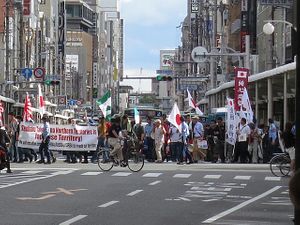The Senkaku Islands (known in China as the Diaoyu Islands) comprise a group of five islands, including Uotsuri, Kuba (or Kobisho) and Taisho (or Sekibisho), along with three reefs. The Senkaku are part of the territory of Japan, in light of historical facts and based on international law. Indeed, the islands are under the effective control of Japan. There exists no issue of territorial sovereignty to be resolved concerning the Senkaku Islands.
The Japanese government first surveyed the Senkaku Islands in September 1885 and, having carefully confirmed that the islands were not only “previously uninhabited” (as described in Cabinet decision materials) but also showed no trace of having been under the control of any country, incorporated the islands into Okinawa Prefecture through a January 1895 Cabinet decision. These measures correspond to “occupation” as defined under international law – in other words, acquiring territorial sovereignty over terra nullius lying outside the control of any state by exercising effective control over the said terra nullius prior to any other state with the intention of claiming sovereignty over that territory.
Following a survey report on coastal mineral resources conducted by the United Nations Economic Commission for Asia and the Far East (ECAFE) in the fall of 1968, which suggested massive petroleum and gas reserves in the seabed areas around the islands, China’s Ministry of Foreign Affairs issued a declaration on December 30, 1971, which marked the launch of formal claims by the Chinese government to sovereignty over the Senkaku. Let’s consider this in its historical context.
The September 1951 San Francisco Peace Treaty finalized the legal apportionment of Japanese territory, with article 2 (b) stating that “Japan renounces all right, title and claim to Formosa and the Pescadores,” while Article 3 makes the United States the administering authority (under the trusteeship system) over “Nansei Shoto south of 29° north latitude (including the Ryukyu Islands and the Daito Islands).” The Japanese government interprets this to mean that the Senkaku Islands are not included in “Formosa and the Pescadores” but are rather part of “Nansei Shoto south of 29 north latitude.” The “Agreed Minutes” attached to the Okinawa reversion agreement signed in June 1971 note that the territories to be returned to Japan under the agreement are those under the administration of the United States pursuant to Article 3 of the San Francisco Peace Treaty, and lists the latitude and longitude of the territories to be returned as those designated under Civil Administration Proclamation No. 27 of December 25, 1953, which also includes the Senkaku Islands. (A map of these territories can be found here.)
After landing on the main island of Okinawa, the U.S. Forces issued U.S. Navy Military Government Proclamation No. 1 in April 1945 and then extended the same proclamation to the Yaeyama Islands in November that year. In April 1948, the United States designated Kuba Island (one of the Senkaku Islands) as a “permanent danger area” and established a bombing range there. The U.S. military also set up a bombing range on Taisho Island in April 1956. Even after administration over Okinawa was returned to Japan in May 1972, the U.S.-Japan Joint Committee, established under Article 25.1 of the Japan-U.S. Status of Forces Agreement, agreed that U.S. Forces would continue to use the Kuba and Taisho bombing ranges pursuant to Article 2.1 (a) of the same agreement, and these ranges continue to exist today.
However, despite its claims that Kuba and Taisho are “China’s inherent territory,” the Chinese government made no protest until December 1971 to the Japanese and/or the U.S. government in regard to the two islands being placed under U.S. military occupation and administration as from 1948, to the inclusion of the Senkaku Islands as part of the “territories to be returned” to Japan under the June 1971 Okinawa reversion agreement, or to the designation of the two islands as part of the “facilities and areas in Japan” which the United States is granted permission to use pursuant to Article 2.1 (a) of the Japan-U.S. Status of Forces Agreement.
This long silence on the part of the Chinese government clearly contradicts its territorial claims to the Senkaku Islands and constitutes acquiescence under international law. In the 1962 Judgment on the “Case concerning the Temple of Preah Vihear between the Kingdom of Cambodia and the Kingdom of Thailand,” the International Court of Justice stated that when a protest should be lodged and it is possible to do so, no protest (silence) for many years must be held to have acquiesced. A country which acquiesces loses the ability to repudiate either the claim of another country to the territory subject to the said acquiescence or the validity of the exercise of control pursuant to the said claim. Further, in the case that a country that has acquiesced, or at least not protested, is the only potential claimant that could claim sovereignty over the territory in question, the fact of acquiescence can play a decisive role.
Jun Tsuruta is an associate professor at Meiji Gakuin University.

































